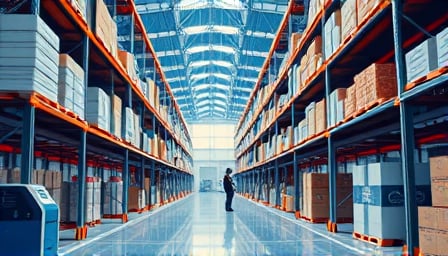Corporate News Analysis – Zalando SE
Zalando SE, the German‑based internet and catalog retailer, has reported a robust performance in September, reflected by a notable rise in its share price. The acquisition of About You—a fast‑growing fashion platform—has been interpreted by market observers as a strategic pivot aimed at revitalising the company’s growth trajectory. Goldman Sachs’ reaffirmation of a “Buy” recommendation has amplified investor confidence and contributed to the recent 0.47 % single‑day uptick in the stock, while the firm’s market capitalisation has continued to climb.
Impact on Supply Chain and Logistics Infrastructure
Zalando’s expansion into new product categories and geographic markets requires significant upgrades to its distribution network. The company’s logistics centres increasingly rely on automated storage‑and‑retrieval systems (AS/RS) and collaborative robots (cobots) to optimise order picking and reduce cycle times. Recent capital outlays include the deployment of 3‑axis robotic arms for palletisation and the installation of vision‑guided sorting stations that can process upwards of 1,200 items per hour. These investments are consistent with broader industrial trends where high‑value, fast‑turnover goods demand precision handling to maintain inventory accuracy and meet the stringent delivery windows expected by consumers.
The return‑rate challenge—particularly the surge in customers exploiting the generous return policy—has forced Zalando to re‑evaluate its reverse‑logistics capacity. The firm has announced stricter return controls, including the temporary blocking of repeat offenders, to curb the financial burden associated with processing and refurbishing returned merchandise. From an engineering standpoint, this translates into a need for more sophisticated sorting algorithms that can quickly identify and segregate items destined for refurbishment versus those that can be returned to stock. The investment in machine‑learning‑based predictive analytics to forecast return volumes will likely reduce the required physical infrastructure, thereby lowering the capital expenditure burden.
Capital Expenditure Trends in the Heavy‑Industry Context
Although Zalando operates in the digital retail space, its capital expenditure patterns mirror those seen in traditional heavy‑industry manufacturing. The emphasis on automation, real‑time data acquisition, and predictive maintenance aligns with the Industry 4.0 paradigm. In the broader economic environment, rising material costs (particularly steel and aluminum for conveyor systems) and tightening regulatory standards on energy efficiency have prompted firms like Zalando to adopt more energy‑efficient equipment—such as variable‑frequency drives on conveyors and LED‑based lighting—to achieve lower operating costs and compliance with the European Union’s Energy Efficiency Directive (EED).
Capital budgets are also influenced by macro‑economic factors such as interest‑rate fluctuations and the availability of green‑bond financing. Zalando’s recent financing of logistics upgrades through a mix of equity and debt instruments illustrates how firms leverage favourable capital markets to fund infrastructure improvements without compromising liquidity. The company’s focus on “net‑zero” targets—through electrification of its delivery fleet and carbon‑neutral warehousing—has opened additional channels for government subsidies and tax incentives, further easing capital constraints.
Regulatory and Market Implications
The European Commission’s forthcoming amendments to the Digital Services Act (DSA) and the General Data Protection Regulation (GDPR) revisions will require Zalando to invest in data‑privacy‑conformant IT systems across its supply chain. These regulatory changes will likely increase the need for secure data centres and enhanced encryption capabilities, thereby influencing the company’s IT capital expenditure decisions.
Moreover, the shift towards more sustainable logistics—driven by consumer expectations and regulatory pressure—has led to a surge in demand for electric forklifts and battery‑operated pallet jacks. Zalando’s integration of such equipment into its warehouses is anticipated to reduce operating costs and improve worker safety, while also aligning the company with the European Green Deal’s objectives.
Conclusion
Zalando’s recent acquisition of About You and its proactive measures to curb excessive returns demonstrate a strategic intent to strengthen its market position and operational resilience. The company’s capital investment strategy—rooted in automation, predictive analytics, and energy‑efficient equipment—mirrors the industrial manufacturing sector’s push towards higher productivity and sustainability. While regulatory developments and supply‑chain disruptions pose ongoing challenges, Zalando’s focused investment in advanced logistics infrastructure positions it favourably to sustain growth in an increasingly competitive e‑commerce landscape.
